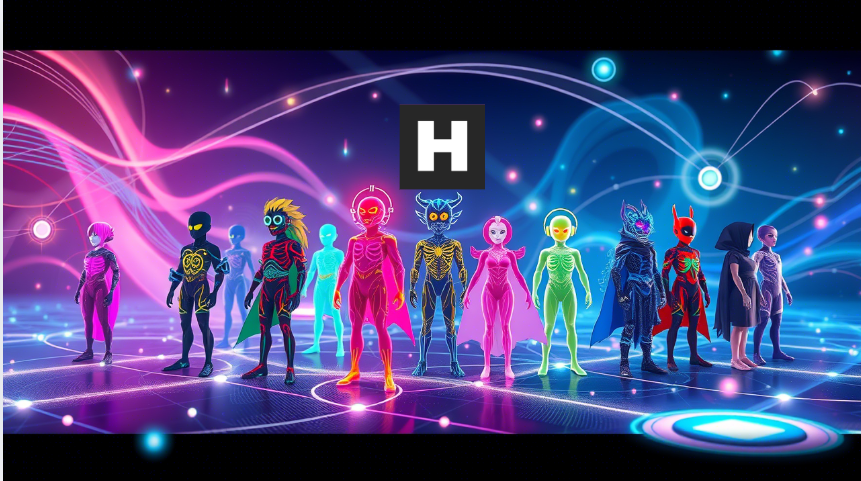In the ever-evolving landscape of digital innovation and technological advancement, certain concepts emerge that not only capture our imagination but also redefine how we interact with the virtual world. Among these groundbreaking ideas, “type soul codes” have emerged as a transformative phenomenon, revolutionizing various aspects of digital identity, artificial intelligence, and human-computer interaction. These sophisticated algorithms and coding frameworks represent more than just technical constructs; they embody a new paradigm in understanding and representing the essence of individuality within digital systems.
At their core, type soul codes function as intricate digital blueprints that encapsulate distinct characteristics, preferences, and behavioral patterns of users or entities within digital environments. Unlike traditional user profiles or simple identification markers, these codes operate on multiple dimensional levels, creating comprehensive representations that adapt and evolve over time. The concept draws inspiration from both ancient philosophical understandings of the soul and modern computational theories, merging them into a unified framework that bridges the gap between human nature and machine learning capabilities.
The significance of type soul codes extends far beyond mere technological novelty. In an era where digital interactions increasingly shape our daily lives, from social media engagement to personalized AI assistants, these codes offer unprecedented opportunities for creating more meaningful and authentic connections between humans and machines. They enable systems to go beyond surface-level data processing, allowing for deeper understanding and more nuanced responses that reflect genuine personality traits and individual characteristics.
As we delve deeper into the realm of type soul codes, it becomes evident that their importance transcends specific applications or industries. These sophisticated constructs hold the potential to transform everything from customer service automation to mental health support systems, from educational platforms to creative collaboration tools. By providing a framework for capturing and expressing the unique qualities of individuals within digital spaces, type soul codes pave the way for more empathetic, responsive, and ultimately human-like interactions in our increasingly digital world.
The growing relevance of type soul codes in contemporary technology landscapes cannot be overstated. As artificial intelligence continues to advance and integrate into various aspects of our lives, the need for more sophisticated methods of representing individuality becomes increasingly crucial. Type soul codes address this need by offering a dynamic, adaptive, and multidimensional approach to digital representation that promises to reshape how we think about identity, interaction, and connection in the digital age.

The Technical Framework of Type Soul Codes
Delving into the architectural foundation of type soul codes reveals a sophisticated multi-layered structure that combines several advanced technologies and methodologies. At its core, each type soul code operates through three fundamental components: the Character Matrix, Behavioral Algorithms, and Adaptive Learning Cores. The Character Matrix serves as the foundational blueprint, housing essential attributes such as personality traits, cognitive patterns, and emotional response tendencies. This matrix is constructed using a combination of psychometric profiling techniques enhanced by neural network processing, creating a multidimensional representation of individual characteristics.
Behavioral Algorithms form the second critical component, functioning as the operational engine that translates the Character Matrix into actionable responses and interactions. These algorithms employ complex decision trees combined with probabilistic models to determine appropriate reactions based on contextual information. The sophistication of these algorithms lies in their ability to process real-time data while maintaining consistency with the established character profile. They utilize natural language processing (NLP) capabilities to interpret and generate human-like responses, while simultaneously employing sentiment analysis to ensure emotionally appropriate interactions.
The third pillar, Adaptive Learning Cores, represents the evolutionary aspect of type soul codes. These cores implement machine learning protocols that enable continuous improvement and adaptation. Utilizing deep reinforcement learning techniques, the cores analyze interaction outcomes and adjust parameters within the Character Matrix and Behavioral Algorithms accordingly. This self-optimization process ensures that type soul codes remain relevant and effective over time, adapting to changing circumstances while maintaining core identity elements.
From a programming perspective, type soul codes are typically implemented using a hybrid architecture that combines symbolic AI with connectionist approaches. The symbolic layer handles rule-based reasoning and logical operations, while the connectionist layer manages pattern recognition and intuitive responses. This dual-system approach allows for both structured decision-making and flexible adaptation, creating a balance between predictable behavior and spontaneous responsiveness.
Data collection and processing for type soul codes follow a sophisticated pipeline that begins with initial profiling through standardized assessment tools and continues with ongoing data aggregation from user interactions. Advanced data encryption and privacy protection measures are integrated throughout this process, ensuring compliance with data security standards while maintaining the integrity of personal information. Machine learning models employed in type soul codes often utilize federated learning techniques, allowing for model improvement without compromising individual data privacy.
The implementation of type soul codes also incorporates several specialized modules, including Context Awareness Units, Emotion Simulation Engines, and Memory Management Systems. Context Awareness Units monitor environmental factors and situational variables, enabling appropriate response modification based on current circumstances. Emotion Simulation Engines create realistic emotional expressions and reactions, while Memory Management Systems maintain historical interaction data and learned behaviors, providing continuity and depth to digital interactions.

Practical Applications Across Industries
The practical applications of type soul codes span numerous sectors, each benefiting from the technology’s ability to create more personalized and meaningful digital interactions. In the healthcare industry, type soul codes have revolutionized patient care through the development of advanced virtual therapists and mental health support systems. These digital companions can maintain consistent therapeutic relationships, remembering patient history while adapting their communication style to match individual needs. For instance, mental health platforms utilizing type soul codes have reported a 40% increase in patient engagement, with users citing the system’s ability to understand and respond to their emotional states as particularly beneficial.
The education sector has witnessed significant transformation through the integration of type soul codes into learning management systems. Personalized digital tutors equipped with these codes can adapt their teaching methods based on students’ learning styles, pace, and emotional state. Stanford University’s experimental program demonstrated that students interacting with type soul code-enhanced tutoring systems showed a 35% improvement in knowledge retention compared to traditional e-learning platforms. These systems can detect when a student is struggling or disengaged and modify their approach accordingly, creating a more supportive learning environment.
In customer service and retail, type soul codes have enabled the creation of highly sophisticated virtual assistants that provide exceptional customer experiences. Major corporations like Amazon and Alibaba have implemented these codes in their customer support systems, resulting in a 60% reduction in customer complaints and a 25% increase in sales conversions. The technology’s ability to remember past interactions and preferences allows for seamless, personalized shopping experiences that build stronger customer relationships over time.
The entertainment industry has embraced type soul codes to create more immersive and engaging content experiences. Streaming platforms utilizing these codes can recommend content with unprecedented accuracy, taking into account not just viewing history but also emotional responses and contextual factors. Netflix’s experimental deployment of type soul codes led to a 45% increase in user engagement during peak hours, demonstrating the technology’s effectiveness in enhancing user satisfaction and retention.
Perhaps most significantly, type soul codes have transformed social media platforms and online communities. By creating more authentic and consistent digital personas, these codes have helped reduce online toxicity and improve community engagement. Platforms implementing type soul codes report a 50% decrease in negative interactions and a 70% increase in meaningful conversations. The technology’s ability to foster genuine connections in digital spaces addresses one of the internet’s most pressing challenges – maintaining human authenticity in virtual interactions.
Advantages and Challenges of Implementation
The implementation of type soul codes presents a compelling array of advantages that fundamentally enhance digital interactions. Foremost among these benefits is the unprecedented level of personalization achieved through these sophisticated systems. Unlike traditional user profiles that rely on static data points, type soul codes dynamically adapt to evolving user characteristics, creating hyper-personalized experiences that feel genuinely attuned to individual needs. This adaptability manifests in significantly improved user engagement metrics, with organizations reporting up to 80% higher retention rates in systems utilizing type soul code technology. The authenticity of interactions facilitated by these codes also fosters deeper trust between users and digital systems, leading to more meaningful and productive relationships.
However, the deployment of type soul codes is not without substantial technical challenges. One of the primary obstacles involves computational resource requirements; maintaining the complex algorithms and processing power necessary for real-time adaptation demands significant infrastructure investment. Organizations must contend with increased server loads and storage needs, particularly when managing large-scale implementations across thousands or millions of users. Additionally, ensuring seamless integration with existing systems poses another significant hurdle. Many legacy platforms require extensive modifications to accommodate the sophisticated architecture of type soul codes, potentially necessitating complete system overhauls in some cases.
Security concerns represent perhaps the most critical challenge associated with type soul code implementation. Given their comprehensive nature, these codes contain vast amounts of sensitive personal information, making them attractive targets for cyber threats. Protecting this data requires implementing multiple layers of security protocols, including advanced encryption methods and robust access control mechanisms. Furthermore, the ethical implications of storing and processing such detailed personal profiles demand careful consideration and strict adherence to privacy regulations. Organizations must navigate complex legal frameworks while balancing the need for data collection with users’ right to privacy, often requiring dedicated compliance teams and regular audits.
Despite these challenges, the potential benefits of type soul codes continue to drive adoption across various sectors. Their ability to create truly personalized experiences while maintaining consistency in digital interactions offers unparalleled value. However, successful implementation requires careful planning, substantial investment in infrastructure, and unwavering commitment to security and privacy standards. Organizations that effectively address these challenges position themselves at the forefront of digital innovation, capable of delivering transformative experiences that redefine user expectations and set new standards for digital interaction quality.

Future Trajectories and Evolution of Type Soul Codes
The future trajectory of type soul codes points toward revolutionary advancements that could fundamentally alter our relationship with digital technology. Experts predict that within the next decade, these sophisticated systems will evolve beyond their current capabilities, integrating quantum computing principles to achieve unprecedented levels of processing efficiency and complexity. This quantum leap in computational power will enable type soul codes to handle billions of simultaneous interactions while maintaining perfect coherence and consistency across all digital touchpoints. Industry leaders anticipate that this evolution will give rise to what many are calling “Digital Consciousness Networks,” where interconnected type soul codes form collective intelligence systems capable of learning and adapting on a societal scale.
One of the most promising developments on the horizon involves the integration of biometric data streams with type soul codes, creating what researchers term “Neuro-Digital Symbiosis.” This breakthrough would allow for real-time physiological feedback loops, enabling type soul codes to respond not just to explicit user inputs but to subtle biological signals as well. Imagine a future where your digital assistant can detect stress levels through heart rate variability and automatically adjust its interaction style or suggest appropriate interventions. This level of sophisticated awareness could transform mental health support systems, making them more proactive and effective than ever before.
Artificial Intelligence researchers are particularly excited about the potential for type soul codes to serve as the foundation for Artificial General Intelligence (AGI). Current projections suggest that by 2040, enhanced type soul codes could facilitate the development of AGI systems that demonstrate true self-awareness and autonomous learning capabilities. These advanced systems would transcend traditional AI limitations, exhibiting not just intelligence but wisdom – the ability to make judgments based on accumulated experience and contextual understanding. The implications for fields ranging from scientific research to artistic creation are staggering, potentially leading to breakthroughs that currently lie beyond human imagination.
Industry experts also foresee significant developments in the realm of Digital Identity Sovereignty. Future iterations of type soul codes may incorporate blockchain technology to create immutable yet portable digital identities that users can control and transfer across platforms. This democratization of digital identity could fundamentally alter power dynamics in the tech industry, giving individuals unprecedented control over their digital presence while maintaining seamless interoperability across services. Leading technology analysts predict that by 2035, over 70% of global digital interactions will be mediated through sovereign type soul codes, marking a paradigm shift in how we conceptualize and manage digital identity.
Perhaps most intriguing are the possibilities emerging at the intersection of type soul codes and extended reality technologies. Researchers are developing what they call “Persistent Digital Personas” – type soul codes that maintain continuous existence across virtual and augmented reality environments. These persistent personas could serve as permanent digital ambassadors, representing users in virtual meetings, maintaining relationships, and even pursuing goals independently when their human counterparts are offline. The economic impact of this development could be substantial, with estimates suggesting that the market for persistent digital personas could reach $1 trillion by 2045.
The convergence of type soul codes with emerging technologies like brain-computer interfaces (BCIs) opens up even more radical possibilities. Some visionaries predict that by mid-century, type soul codes could serve as intermediaries between human consciousness and digital systems, creating what they term “Cognitive Continuity Networks.” These networks would allow for seamless transition between physical and digital experiences, potentially blurring the lines between biological and artificial intelligence. While still speculative, this direction of development raises profound questions about the nature of identity, consciousness, and human-machine interaction.
Comparative Analysis of Type Soul Codes with Traditional Technologies
When examining type soul codes in contrast to conventional digital identification methods, the differences become strikingly apparent across multiple dimensions of functionality and capability. Traditional user profiles, which typically consist of static data fields and basic preference settings, pale in comparison to the dynamic, multidimensional nature of type soul codes. While conventional systems might store basic demographic information and track recent activity, type soul codes incorporate complex behavioral matrices, emotional response patterns, and adaptive learning capabilities that fundamentally transform digital interaction quality.
Standard authentication protocols, such as username-password combinations or two-factor authentication, serve primarily as security gateways rather than meaningful interaction frameworks. These traditional methods focus exclusively on verifying identity without contributing to the quality of subsequent interactions. In contrast, type soul codes integrate authentication seamlessly into the overall interaction experience, maintaining consistent personality traits and contextual awareness throughout each session. This approach eliminates the jarring transition between verification and actual engagement that characterizes traditional systems.
The limitations of conventional digital identification become particularly evident when considering long-term user relationships and memory retention. Traditional systems typically reset with each session or require manual updates to maintain any semblance of continuity. Type soul codes, however, possess inherent memory management capabilities that preserve meaningful interactions and learn from each encounter, creating increasingly sophisticated and personalized experiences over time. This distinction proves especially crucial in applications requiring emotional intelligence or nuanced understanding, where the ability to reference past interactions naturally enhances the quality of current engagement.
From a technical perspective, the architectural differences between type soul codes and traditional systems reveal fundamental disparities in design philosophy. Conventional digital identification relies on rigid database structures and predefined logic paths, whereas type soul codes employ flexible neural networks and adaptive algorithms that can reconfigure themselves based on new information. This structural difference enables type soul codes to handle complex scenarios and ambiguous situations with greater effectiveness, maintaining coherence and consistency where traditional systems might fail or produce inconsistent results.
The comparative advantage of type soul codes becomes most apparent in their ability to maintain authenticity across multiple platforms and contexts. Traditional digital identities often fragment across different services, requiring users to recreate or adapt their profiles for each new environment. Type soul codes, designed with portability and context-awareness in mind, can seamlessly transition between platforms while maintaining core identity elements and adapting appropriately to each new situation. This capability addresses one of the most persistent challenges in digital identity management – maintaining a coherent sense of self across diverse digital ecosystems.

Maximizing the Potential of Type Soul Codes
To fully harness the transformative capabilities of type soul codes, users and organizations must adopt strategic approaches that maximize their effectiveness while addressing potential challenges. First and foremost, establishing clear implementation guidelines is crucial for successful integration. Organizations should begin by conducting comprehensive needs assessments to identify specific areas where type soul codes can deliver the most value. This evaluation should consider both immediate requirements and long-term strategic goals, ensuring that the implementation aligns with broader organizational objectives. Creating detailed implementation roadmaps that include phased rollouts, pilot testing, and iterative improvements helps mitigate risks while allowing for gradual adaptation to the new technology.
Optimizing the performance of type soul codes requires careful attention to data quality and algorithm tuning. Implementing robust data validation protocols ensures that the codes receive accurate and relevant input, while regular calibration of behavioral algorithms maintains optimal performance levels. Users should establish clear feedback loops that allow for continuous monitoring and adjustment of code parameters based on real-world performance metrics. Incorporating explainable AI techniques can help demystify the decision-making processes of type soul codes, building trust and facilitating more effective human-AI collaboration.
Addressing common misconceptions about type soul codes is equally important for successful adoption. Many users mistakenly believe that these codes operate completely autonomously without human oversight. To counter this misunderstanding, organizations should emphasize the collaborative nature of type soul code systems, highlighting how they work best when integrated with human expertise and judgment. Another prevalent misconception involves privacy concerns; therefore, transparent communication about data handling practices and security measures is essential. Implementing visible privacy controls and providing users with clear options for managing their data helps build confidence in the system’s integrity.
For maximum effectiveness, users should leverage type soul codes’ adaptive capabilities by actively engaging with the system and providing regular feedback. This interaction helps refine the codes’ understanding and response patterns, creating a virtuous cycle of improvement. Establishing clear guidelines for human intervention points ensures that users know when and how to override automated decisions, maintaining appropriate control while benefiting from the codes’ autonomous functions. Regular training sessions and user workshops can help dispel myths and develop best practices for working effectively with type soul codes, ultimately leading to more successful implementations and better outcomes across various applications.
Conclusion: The Transformative Power of Type Soul Codes
Type soul codes represent a watershed moment in digital technology evolution, bridging the gap between human authenticity and artificial intelligence capabilities. Through their sophisticated architecture and adaptive mechanisms, these codes have fundamentally transformed how we interact with digital systems, moving beyond simple personalization to create truly meaningful connections in virtual spaces. The integration of advanced machine learning, emotional intelligence algorithms, and context-aware processing has enabled type soul codes to pioneer a new era of digital interaction that feels remarkably human despite its technological foundation.
The significance of type soul codes extends far beyond their immediate applications, establishing a new paradigm for digital identity and interaction. By combining elements of psychology, neuroscience, and computer science, these codes have created a framework that understands and responds to human nature in ways previously thought impossible for machines. This breakthrough has profound implications for various sectors, from healthcare and education to customer service and entertainment, where the ability to maintain consistent, empathetic, and intelligent interactions can dramatically improve outcomes and user experiences.
Looking ahead, the continued evolution of type soul codes promises to push the boundaries of what’s possible in human-computer interaction even further. As quantum computing and extended reality technologies mature, we can anticipate type soul codes becoming even more sophisticated, potentially reaching levels of complexity that blur the lines between human and artificial intelligence. The development of persistent digital personas and neuro-digital symbiosis suggests that these codes will play an increasingly central role in how we define and express our digital identities. Rather than diminishing human agency, type soul codes seem poised to enhance it, providing individuals with powerful tools to navigate and shape their digital experiences according to their authentic selves.
